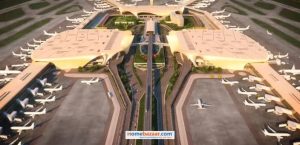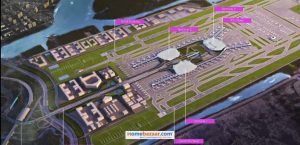There is a key update on the most anticipated Navi Mumbai International Airport. Its first look has been officially released. But before diving into the details of Navi Mumbai International Airport, let’s understand why it is so important.
Navi Mumbai International Airport is a doorway to Navi Mumbai’s economic transformation. It promises a positive economic and social shift of the region by generating nearly 142,000 direct and 200,000 indirect job opportunities.
Besides, it will create a strong infrastructure network around Navi Mumbai boosting the capital value in the region.
The project has an estimated cost of 16700 crores. And to be developed by Adani Group along with the award-winning architect Zaha Hadid. It will be developed in four phases. The first phase will be in full operation by 2025.
A world-class master plan, exceptional terminal infrastructure, and next-generation technology are the main design features. So let’s delve into these features one by one and see what makes them remarkable.
Page Contents

The airport will be spanned over an area of 1,160 hectares and with a capacity for catering to more than 90 million passengers per year. The airport will be consist of three linked multi-level terminals placed around the central forecourt. It will have a multimodal transportation hub too.
The airport will be easily reachable by highway, suburban railways, and metro. It will also have a separate water transport connectivity.
It will have dual entrances. From the east side, NH4B and from the west Amra Marg will provide connectivity to the airport.
The General Features of the Navi Mumbai Airport Are:
- Two parallel runways for independent and simultaneous operation.
- Multipoint connectivity via rail, road, and water.
- There will be nine plus nine lanes that will connect the central terminal complex.
- Passenger-related facilities section will be planned at the Western and Northern parts.
- Maintenance, repair, and cargo sections will be at the eastern part of the airport.
- Other features such as a taxiway, a water treatment plant, and a power supply system.
Exceptional Passenger Terminal Design

The Navi Mumbai International Airport will have a grand passenger entrance. It will be organized over the two floors crafted specifically for easy navigation and minimum walking distance.
The drop-off area, security checks, shopping area, lounge area are designed for seamless navigation. Also, the highly efficient departure gates are designed without the need for a vertical transport system.
The lotus petal theme in the terminal will be an attraction for the passengers. Evoking the cultures of India will be a core theme of the terminal interior design.
Next-Generation Technology
One of the main aspects of the Navi Mumbai International Airport is its deployment of Next-Generation technology in the operation. Many of the airport operations will use Artificial Intelligence.
It also uses a world-class range of advanced lighting including runway edge lights and apron floodlights. Moreover, it encompasses Advanced visual landing aids with precision approach path indicators.
- The construction of Mumbai International Airport was approved by the Government Of Maharashtra In July 2008.
- In 2017, GVK Group had won the bid to develop the airport with the highest 74% stake leaving CIDCO and Airport Authority Of India 13% Each. Recently, In September 2020 Adani bought GVK’s entire stake and became the chief developer.
- The Navi Mumbai International Airport will be just 36 kilometers from the Chhatrapati Shivaji International Airport.
- There has been a growing controversy around the naming of the Navi Mumbai International Airport.
- The Project has been delayed because of procedural issues, the GVK group’s financial crisis, and Covid 19 Pandemic.
- Navi Mumbai real estate will get a solid boost from the international airport. Airport’s proximity will benefit the nearby localities such as Panvel, Ulwe, Kopar Khairane, Seawoods, Sanpada and it will also boost the overall growth of real estate in Navi Mumbai & neighboring districts.








